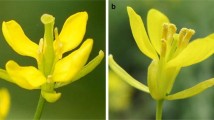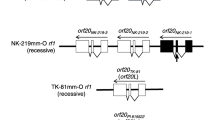Abstract
Cytoplasmic male sterility (CMS) is a mitochondrion-encoded trait specifically affecting anthers. Several male sterility-inducing mitochondrial types are known, many of which affect the development of anther tapetum cells, but no sound explanation for this tissue's vulnerability has been proposed. Insights into the cause of CMS can be obtained by the detailed phenotypic comparison of different male sterility-inducing mitochondrial types of the same plant species. In pursuit of this objective, we conducted an investigation into anther development in two sugar beet CMS lines. We compared an Owen type CMS line used for hybrid breeding with the G type CMS line derived from wild beet. Both CMS lines have the same nuclear background. The tapetum of the G CMS line exhibited hypertrophy in the microspore stage, as reported previously in Owen CMS lines. Ultrastructural analysis revealed mitochondrial abnormalities, including low electron density and aberrant cristae appearing in the tapetum after meiosis in both lines. The Owen CMS line lacked Ubisch bodies and had poorly developed bacula and tecta in the pollen cell walls, whereas the G CMS line retained these features, but the pollen wall was highly deformed. Ultimately, microspores and the tapetum degenerated in both lines, and the male sterile phenotypes were eventually very similar. Although it had been hypothesized that mitochondrial activation was associated with CMS expression, mitochondria in the root apical meristem appeared normal in beet roots with G- and Owen type mitochondria. We propose that CMS expression includes at least two mechanisms: one triggers abnormal mitochondrial generation, and the other affects the type of developmental abnormality.







Similar content being viewed by others
Data availability
All data supporting the findings of this study are available within the paper.
References
Alexander MP (1969) Differential staining of aborted and nonaborted pollen. Stain Technol 44:117–122. https://doi.org/10.3109/10520296909063335
Arakawa T, Ue S, Sano C, Matsunaga M, Kagami H, Yoshida Y, Kuroda Y, Taguchi K, Kitazaki K, Kubo T (2019) Identification and characterization of a semi-dominant restorer-of-fertility 1 allele in sugar beet (Beta vulgaris). Theor Appl Genet 132:227–240. https://doi.org/10.1007/s00122-018-3211-6
Ariizumi T, Toriyama K (2011) Genetic regulation of sporopollenin synthesis and pollen exine development. Annu Rev Plant Biol 62:437–460. https://doi.org/10.1146/annurev-arplant-042809-112312
Ayabe H, Toyoda A, Iwamoto A, Tsutsumi N, Arimura S (2023) Mitochondrial gene defects in Arabidopsis can broadly affect mitochondrial gene expression through copy number. Plant Physiol 191:2256–2275. https://doi.org/10.1093/plphys/kiad024
Balk J, Leaver CJ (2001) The PET1-CMS mitochondrial mutation in sunflower is associated with premature programmed cell death and cytochrome c release. Plant Cell 13:1803–1818. https://doi.org/10.1105/TPC.010116
Cogliati S, Enriquez JA, Scorrano L (2016) Mitochondrial cristae: where beauty meets functionality. Trends Biochem Sci 41:261–273. https://doi.org/10.1016/j.tibs.2016.01.001
Colas des Francs-Small C, Small I (2014) Surrogate mutants for studying mitochondrially encoded functions. Biochimie 100(234):242. https://doi.org/10.1016/j.biochi.2013.08.019
Colhoun CW, Steer MW (1981) Microsporogenesis and the mechanism of cytoplasmic male sterility in maize. Ann Bot 48:417–424
Darracq A, Varré JS, Maréchal-Drouard L, Courseaux A, Castric V, Saumitou-Laprade P, Oztas S, Lenoble P, Vacherie B, Barbe V et al (2011) Structural and content diversity of mitochondrial genome in beet: a comparative genomic analysis. Genome Biol Evol 3:723–736. https://doi.org/10.1093/gbe/evr042
Ducos E, Touzet P, Boutry M (2001) The male sterile G cytoplasm of wild beet displays modified mitochondrial respiratory complexes. Plant J 26:171–180. https://doi.org/10.1046/j.1365-313x.2001.01017.x
Gong F, Takahashi H, Omori F, Wang W, Mano Y, Nakazono M (2019) QTLs for constitutive aerenchyma from Zea nicaraguensis improve tolerance of maize to root-zone oxygen deficiency. J Exp Bot 70:6475–6487. https://doi.org/10.1093/jxb/erz403
Hagihara E, Itchoda N, Habu Y, Iida S, Mikami T, Kubo T (2005) Molecular mapping of a fertility restorer gene for Owen cytoplasmic male sterility in sugar beet. Theor Appl Genet 111:250–255. https://doi.org/10.1007/s00122-005-2010-z
Hanson MR, Bentolila S (2004) Interactions of mitochondrial and nuclear genes that affect male gametophyte development. Plant Cell 16:S154–S169. https://doi.org/10.1105/tpc.015966
Hjerdin-Panagopoulos A, Kraft T, Rading IM, Tuvesson S, Nilsson NO (2000) Three QTL regions for restoration of Owen CMS in sugar beet. Crop Sci 42:540–544. https://doi.org/10.2135/cropsci2002.5400
Hoeberichts FA, Woltering EJ (2003) Multiple mediators of plant programmed cell death: interplay of conserved cell death mechanisms and plant-specific regulators. BioEssays 25:47–57. https://doi.org/10.1002/bies.10175
Honma Y, Taguchi K, Hiyama H, Yui-Kurino R, Mikami T, Kubo T (2014) Molecular mapping of restorer-of-fertility 2 gene identified from a sugar beet (Beta vulgaris L. ssp. vulgaris) homozygous for the non-restoring restorer-of-fertility 1 allele. Theor Appl Genet 127:2567–2574. https://doi.org/10.1007/s00122-014-2398-4
Kawanishi Y, Shinada H, Matsunaga M, Masaki Y, Mikami T, Kubo T (2010) A new source of cytoplasmic male sterility found in wild beet and its relationship to other CMS types. Genome 53:251–256. https://doi.org/10.1139/g10-003
Kim Y-J, Zhang D (2018) Molecular control of male fertility for crop hybrid breeding. Trends Plant Sci 23:53–65. https://doi.org/10.1016/j.tplants.2017.10.001
Kitazaki K, Arakawa T, Matsunaga M, Yui-Kurino R, Matsuhira H, Mikami T, Kubo T (2015) Post-translational mechanisms are associated with fertility restoration of cytoplasmic male sterility in sugar beet (Beta vulgaris). Plant J 83:290–299. https://doi.org/10.1111/tpj.12888
Kitazaki K, Oda K, Akazawa A, Iwahori R (2023) Molecular genetics of cytoplasmic male sterility and restorer-of-fertility for the fine tuning of pollen production in crops. Theor Appl Genet 136:156. https://doi.org/10.1007/s00122-023-04398-8
Klecker T, Westermann B (2021) Pathways shaping the mitochondrial inner membrane. Open Biol 11:210238. https://doi.org/10.1098/rsob.210238
Majewska-Sawka A, Rodriguez-Garcia MI, Nakashima H, Jassen B (1993) Ultrastructural expression of cytoplasmic male sterility in sugar beet (Beta vulgaris L.). Sex Plant Reprod 6:22–32. https://doi.org/10.1007/bf00227579
Matsuhira H, Kitazaki K, Matsui K, Kubota K, Kuroda Y, Kubo T (2022) Selection of nuclear genotypes associated with the thermo-sensitivity of Owen-type cytoplasmic male sterility in sugar beet (Beta vulgaris L.). Theor Appl Genet 135:1457–1466. https://doi.org/10.1007/s00122-022-04046-7
Meyer EH, Lehmann C, Boivin S, Brings L, De Cauwer I, Bock R, Kühn K, Touzet P (2018) CMS-G from Beta vulgaris ssp. maritima is maintained in natural populations despite containing an atypical cytochrome c oxidase. Biochem J 475:759–773. https://doi.org/10.1042/BCJ20170655
Ng MYW, Wai T, Simonsen A (2021) Quality control of the mitochondrion. Dev Cell 56:881–905. https://doi.org/10.1016/j.devcel.2021.02.009
Owen FV (1945) Cytoplasmically inherited male-sterility in sugar beets. J Agric Res 71:423–440
Pillen K, Steinrücken G, Herrmann RG, Jung C (1993) An extended linkage map of sugar beet (Beta vulgaris L.) including nine putative lethal genes and the restorer gene X. Plant Breeding 111:265–272. https://doi.org/10.1111/j.1439-0523.1993.tb00641.x
Pla M, Mathieu C, De Paepe R, Chétrit P, Vedel F (1995) Deletion of the last two exons of the mitochondrial nad7 gene results in lack of the NAD7 polypeptide in a Nicotiana sylvestris CMS mutant. Mol Gen Genet 248:79–88. https://doi.org/10.1007/BF02456616
Radja A (2021) Pollen wall patterns as a model for biological self-assembly. J Exp Zool B Mol Dev Evol 336:629–641. https://doi.org/10.1002/jez.b.23005
Reynolds ES (1963) The use of lead citrate at a high pH as an electron opaque stain in electron microscopy. J Cell Biol 17:208–212. https://doi.org/10.1083/jcb.17.1.208
Satoh M, Kubo T, Nishizawa S, Estiati A, Itchoda N, Mikami T (2004) The cytoplasmic male-sterile type and normal type mitochondrial genomes of sugar beet share the same complement of genes of known function but differ in the content of expressed ORFs. Mol Genet Genomics 272:247–256. https://doi.org/10.1007/s00438-004-1058-9
Scheffler IE (1999) Mitochondria. Wiley-Liss, New York, pp 273–325
Schnable PS, Wise RP (1998) The molecular basis of cytoplasmic male sterility and fertility restoration. Trends Plant Sci 3:175–180. https://doi.org/10.1016/S1360-1385(98)01235-7
Schondelmaier J, Jung C (1997) Chromosomal assignment of the nine linkage groups of sugar beet (Beta vulgaris L.) using primary trisomics. Theor Appl Genet 95:590–596. https://doi.org/10.1007/s001220050600
Takenaka M, Jörg A, Burger M, Haag S (2019) RNA editing mutants as surrogates for mitochondrial SNP mutants. Plant Physiol Biochem 135:310–321. https://doi.org/10.1016/j.plaphy.2018.12.014
Touzet P, Meyer EH (2014) Cytoplasmic male sterility and mitochondrial metabolism in plants. Mitochondrion 19:166–171. https://doi.org/10.1016/j.mito.2014.04.009
Touzet P, Hueber N, Bürkholz A, Barnes S, Cuguen J (2004) Genetic analysis of male fertility restoration in wild cytoplasmic male sterility G of beet. Theor Appl Genet 109:240–247. https://doi.org/10.1007/s00122-004-1627-7
Wilson ZA, Zhang D-B (2009) From Arabidopsis to rice: pathways in pollen development. J Exp Bot 60:1479–1492. https://doi.org/10.1093/jxb/erp095
Wu HM, Cheun AY (2000) Programmed cell death in plant reproduction. Plant Mol Biol 44:267–281. https://doi.org/10.1023/a:1026536324081
Yamamoto MP, Kubo T, Mikami T (2005) The 5’-leader sequence of sugar beet mitochondrial atp6 encodes a novel polypeptide that is characteristic of Owen cytoplasmic male sterility. Mol Genet Genomics 273:342–349. https://doi.org/10.1007/s00438-005-1140-y
Acknowledgements
We express our sincere thanks to Mr. Toshiaki Ito and Mr. Masanori Yasui, members of the Electron Microscope Laboratory, Research Faculty of Agriculture, Hokkaido University, for their technical assistance and valuable suggestions.
Funding
This work was supported by the Japan Society for the Promotion of Science, Grant-in-Aid for Scientific Research (21H02159 to HM, TK and KK, 22K05569 to HM and KK, and 22H02267 to YK, TK and KK).
Author information
Authors and Affiliations
Contributions
N.K., T.K. and K.K. wrote the main manuscript text, H.M. and Y.K. prepared resources, and N.K., K.I., T.K. and K.K. prepared figures 1-7. All authrers reviewed the manuscript.
Corresponding author
Ethics declarations
Conflict of interest
The authors declare no competing interests.
Additional information
Publisher's Note
Springer Nature remains neutral with regard to jurisdictional claims in published maps and institutional affiliations.
Rights and permissions
Springer Nature or its licensor (e.g. a society or other partner) holds exclusive rights to this article under a publishing agreement with the author(s) or other rightsholder(s); author self-archiving of the accepted manuscript version of this article is solely governed by the terms of such publishing agreement and applicable law.
About this article
Cite this article
Katsura, N., Itoh, K., Matsuhira, H. et al. Two cytoplasmic male sterility phenotypes in beet (Beta vulgaris L.): implications of their simultaneous onset and divergent paths. Euphytica 219, 117 (2023). https://doi.org/10.1007/s10681-023-03244-8
Received:
Accepted:
Published:
DOI: https://doi.org/10.1007/s10681-023-03244-8




